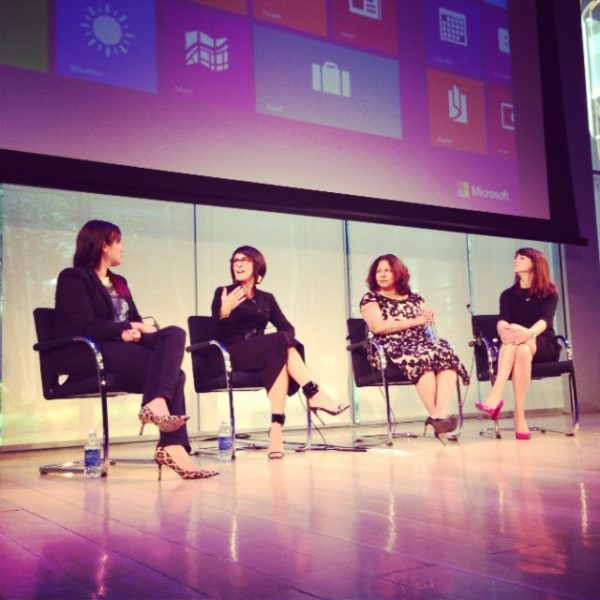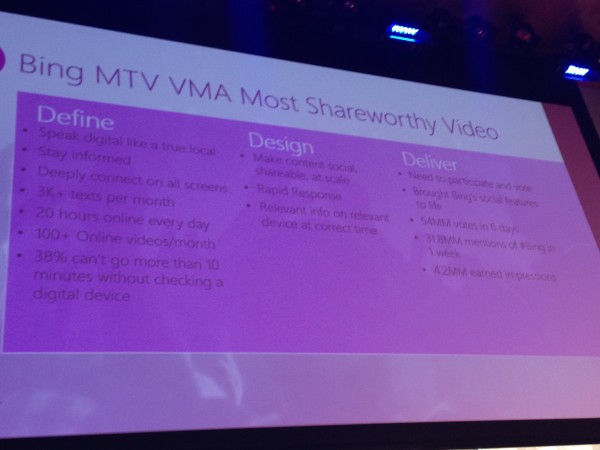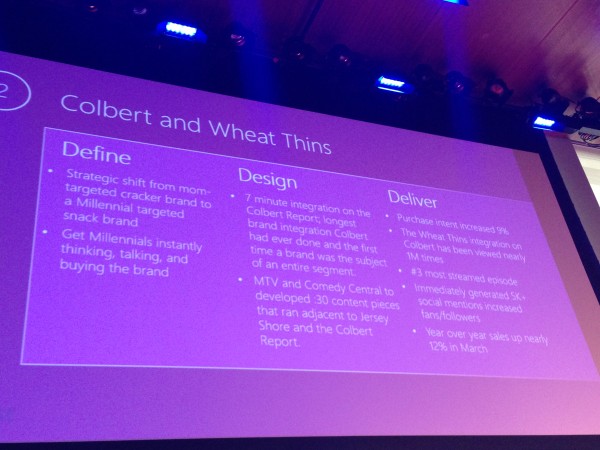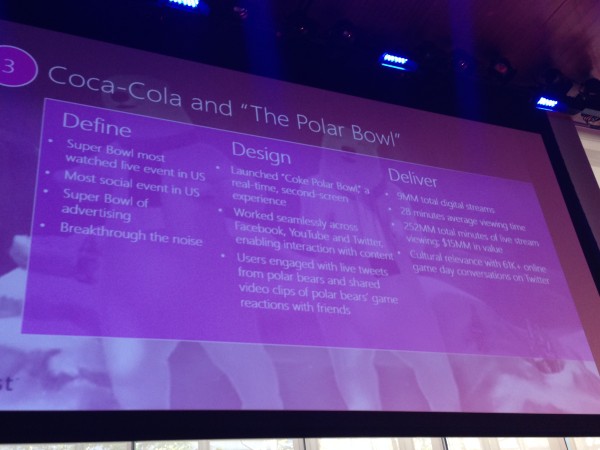Making Multi-Screen Campaigns More Engaging: Tips From 3 Pioneers At #AWX
Welcome back to Marketing Land’s coverage of Advertising Week 2013! The afternoon of Day 2 assembled an esteemed panel of pioneers in the multi-screen campaign space. Lead by moderator Suzan Gursoy, Publisher of ADWEEK, the trio of speakers included Ritu Trivedi, SVP, Digital Strategy & Partnerships, MEDIAVEST, Karen Starns, Edwards GM Bing Consumer Marketing, MICROSOFT, and Aimee Duell EVP […]
Welcome back to Marketing Land’s coverage of Advertising Week 2013! The afternoon of Day 2 assembled an esteemed panel of pioneers in the multi-screen campaign space. Lead by moderator Suzan Gursoy, Publisher of ADWEEK, the trio of speakers included Ritu Trivedi, SVP, Digital Strategy & Partnerships, MEDIAVEST, Karen Starns, Edwards GM Bing Consumer Marketing, MICROSOFT, and Aimee Duell EVP Brand Partnerships, BELIEVE ENTERTAINMENT GROUP.
Yep, they were all women. And yep, they were all smart as you-know-what. Another great thing these speakers brought to the table was they each represented a different perspective: one from the brand angle, one from the agency angle, and one from the creative angle.
Susan kicked off the session by sharing some interesting stats about multi-screen experiences:
- 71% of U.S. consumers view content on two or more screens daily
- 1 in 5 Americans watch TV on a mobile device
“For many of us, a mobile device is our device of choice. It’s the first thing we look at when we wake up in the morning – the last thing we look at before we go to sleep,” Susan commented. Truth.
- 1/3 of Americans own a tablet
Susan pointed out that that number has grown substantially from last year, when it was only 18%.
The Multi-Screen Revolution: Ratio Factor
The more screens we own, the more likely we are to be multi-tasking between screens. If we own a TV and a computer, 52% of us also own another device (are multi-tasking). Throw a smartphone in the equation and that figure jumps to 60%. Add a tablet to that and it hikes to 65%.
If you layer in demographics, the stats get even more interesting. Digital natives under the age of 30 are toggling between devices 27 times per hour. (That’s a really high number!) Non-natives, folks between the ages of 35-55, toggle between devices on an average of 17 times per hour. (Um… that’s still really high!)
Smartphones are the screen of choice for adults 18-34, Susan noted, and tablets are the screen of choice with adults 35-44. “It’s good to know if you’re strategizing for a tablet screen, that your audience is more likely to be in that second age group,” she smartly noted. Additionally, they’re also more likely to live in the suburbs, be considerably affluent, have a higher education, and have more than one child under the age of 18 still living at home. Did you figure all that into your tablet strategy, hmm?
With that, Susan welcomed the first speaker to the state, Ritu.
3D: Define, Design, Deliver
Ritu began by explaining her company’s idea-led process, a.k.a. 3D a.k.a. Define, Design, Deliver.
- Define: This stage is about planning for and thinking about the consumer journey.
- Design: This stage is about designing the product and establishing strategic partnerships.
- Deliver: This stage is about activation, figuring out the tactical approach, thinking about measurement.
All of these stages, incidentally, maintain the consumer at their core. Multi-screen campaigns must be organized in this way (in accordance with this process) in order to be functional, she noted.
She next toured through three case studies, breaking them down by the three Ds.
One of the takeaways from these case studies is the metrics her team reports on to clients are very different then they used to be… now they’re more about engagement, conversation, sharability, advocacy, and the like.
Some final takeaways from Ritu:
- Focus on the consumer journey. Don’t do this just to check the box.
- This is a very iterative process with data and insights. Gather the data and learn from it. You can’t expect to know what everyone’s first screen is. Let the data guide you. “But it’s not data for data sake,” Ritu warned,” it’s important to gather all of those touch points, make sure the measurements are in place, and use those measurements to develop a stronger strategy with your partner.”
- When it comes to creative and multi-screen experiences, remember: You can be on all these screens, but if you’re not talking to consumers in the most relevant fashion, they’re going to tune you out!
Next up was Karen. She shared her own experiences with the Bing It On Challenge (an interactive challenge to show people who use Google as their primary search engine that Bing could be just as good, if not better) – how it evolved and how her team leveraged multi-screen experiences to make the campaign sing.
3 Key Lessons Of Multi-Screen Advertising With Bing It On
- Start by building a great content strategy.
- Invest the time in mapping out a dynamic customer journey.
- Stamp out discipline silos.
Let’s unpack each of those, shall we?
Lesson 1: A well-planned content strategy enables a coordinated customer conversation.
- The customer content must shape the message.
- Content can’t be static. Adapt your content based on engagement, wear out, and campaign evolution.
It’s important to truly tailor content for the device on which it’s meant to be viewed. If this is content for mobile, consider: What is my user’s level of focus? Commitment? How much time do they have to spend with this content? Regarding the Bing It On Challenge, Karen pointed out that they knew people might not have time or have interest in taking the challenge then and there. So their number one call to action (CTA) on mobile was to “Remind Me To Take The Challenge Later.” Conversion rates soared.
Lesson 2: Don’t shortchange mapping out the dynamic customer journey. It’s where the rubber meets the road.
- Physically map out the multiple entry and exit points. It’s not a pretty process, but it’s invaluable.
- Rationalize CTAs.
- Ensure the right content is served up in the right place.
- Adapt based on customer engagement. Are there drop-offs? Where? Why? Is there content people don’t like? Is there a piece of online media that’s not working for us?
Listen, social content and sharability is huge right now, but that doesn’t mean it’s the right answer to everything. “Social sharing has its place, and its super important,” Karen noted, “but it’s not sprinkled everywhere through this campaign,” nor should it be in yours, unless it has a true purpose or need.
Lesson 3: Breaking out of disciplined silos is fundamental.
“It’s incredibly important to do this in order to do multi-screens right,” urged Karen.
- Align your team to an overarching marketing goal. In her team’s case, the perception change (that Bing could be better than Google) we want to drive should be what is important to everyone.
- Drive operational rigor across disciplines. “How are we going to get all of this done in a new way? We had to have the right forms to come together to have the right conversations,” she noted.
- Invest in supporting lasting cultural change!
Last but not least, Aimee took the stage.
She discussed the key challenges of multi-screen campaigns with her team’s project, an animated show called The Le Brons. For this project, her company partnered with Xbox and the U.S. Army – partnerships with built-in audiences that would serve their marketing campaigns nicely. According to Aimee, here’s what it’s all about:
- Balancing creative. When you’re dealing with multiple screens, you have to optimize creative for the behavior of the person in front of that screen.
- Storytelling across screens. This will vary depending on the amount of time a person can spend.
- Harnessing social. If you have a built in audience, why not use it?
- Distribution strategies. This is about getting the word out there to the right people.
She went on to explore each point more deeply:
Balancing Creative:
- You must tread the find line and balance the story with the brand.
- Cleverly balance advertising with entertainment.
- Know your audience and their tolerance for branding.
- The key is adding value!
Storytelling Across Screens:
- Understand consumer behavior across screens. What’s their attention span? How are you telling them a story within that context?
- Leverage longer time spent with additional content.
Harnessing Social
- Tap into an already engaged audience. With this TV show, she was able to leverage LeBron James’s audience, Xbox’s audience, the Army’s audience.
- Share where the audience is already sharing. (Sharing content on LeBron James’s Facebook page yielded massive engagement.)
- Leverage partners for their audience!
Distribution Strategies
- Multiple windows extend campaigns. Aimee’s team started offering the show on Xbox, then moved to YouTube, leveraging an audience they already had.
- Exclusivity by screen to drive traffic. If there’s multiple screens users are playing with, why not use one to drive to the next to drive to the next? Offer something there you can’t get on the previous one.
- Binge watching – Aimee poses this isn’t just a phase. Leverage it by having multiple pieces of content at one point in time where you can allow the consumer to sit for, say, 30 minutes. “Why not?” she challenges.
Many thanks to this panel of marvelously talented ladies for sharing their insights, instincts, and intellect on how brands can best optimize multi-screen experiences for their customer-base! Stay tuned right here on Marketing Land for more full coverage from Advertising Week 2013!
Related stories



